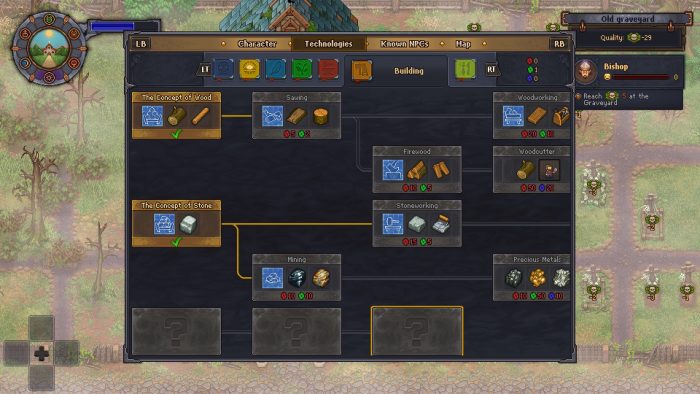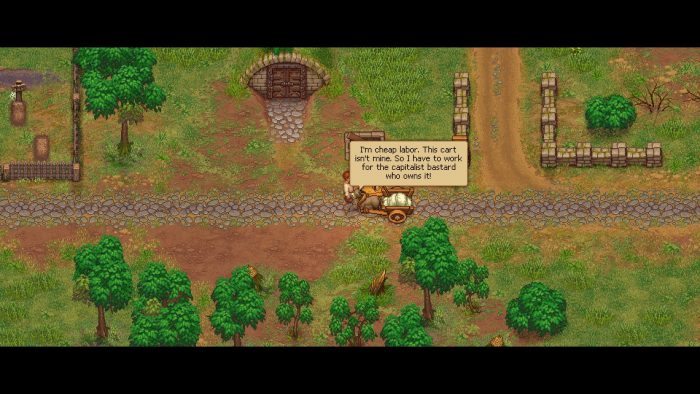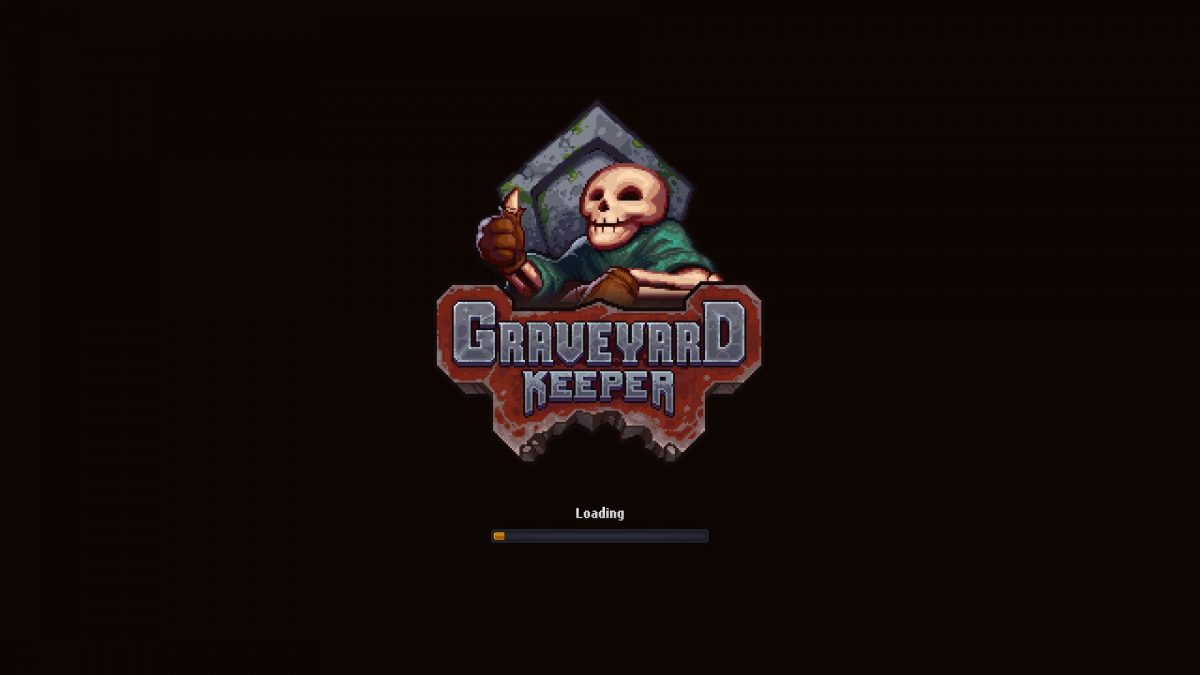I’ve had my eye on Graveyard Keeper for a decent chunk of time. The idea of a game like Stardew Valley — a title I’ve sunk almost 150 hours into — but different enough from Stardew to be fresh was an concept appealing beyond appropriate words. I love these kinds of games. These games have the type of “no pressure but still rewarding” loop that lets me blank out and not really think about anything at all, while still making some amount of progress. It’s why I keep going back to Stardew Valley in the first place.
Graveyard Keeper, though, is just slightly too far off center of that feeling.
In Graveyard Keeper, you maintain a graveyard and church, as well as a homestead, all hampered by a stamina bar that depletes far too quickly. In maintaining the graveyard, you’re required to autopsy and otherwise prepare corpses for burial. Preparing a single body can eat up more than half of your stamina. You then need to build a grave, bury the body, and add accoutrements to the grave in order to raise the rating of your yard. In order to build these grave adornments, you need to chop trees and rocks, then process these logs and stone into items. This also eats up a significant amount of stamina.
After you’ve raised the rating of your graveyard it unlocks the accompanying church, which allows you to give sermons once a week. This can then generate a small amount of an in-game resource called Faith, and it also generates a small amount of money. You’re then tasked to upgrade the interior of the church as well by crafting items to be placed within — a process that eats into your stamina. In the basement of a church is a study bench, allowing you to study items to generate entirely different currencies, based around physical work, natural work, and spiritual work. This all uses stamina.

Along the way you begin to grow crops and move up the technology chains to begin producing even more complex items and tools, all in an effort to upgrade your graveyard, church, home, and complete quests for the oddball residents of the nearby village. Your tools eventually break, requiring them to be re-sharpened with a specific grinder table and a whetstone. The whetstone degrades with use, requiring you to purchase a new one from time to time for a surprising amount of money. Sharpening these tools uses stamina.
Everything in Graveyard Keeper ties back into money and stamina. It’s a world where you have not nearly enough of either and have too much to do all the time. Stamina is recharged by sleeping in your home, or by eating food.
I sleep a lot.
In a game like Stardew Valley, progress feels linear and natural. You just sort of go and eventually you are mining better ores, and growing better food, and it all feels like a natural progression. It guides you well enough that everything feels natural almost immediately, and new mechanics are often explained with short, quick cutscenes. In Graveyard Keeper, almost nothing is explained. You’re left scrambling to figure it out, and figuring out any single thing often leads to progression in spurts. It often seems like nothing is moving forward for hours, and then all of a sudden you’ve figuring one roadblock out and everything is all able to be done all at once — leading to issues with stamina management once again.
For a few examples: There are recipes for materials which require water. It’s never explained how to get water, but if you walk up to a well, you can haul buckets of water. But this does not give you water, it gives you a bucket of water in your inventory which you then need to use to turn it into the actual material water, before it can be used in any recipes. A recipe for ink, an item required both to complete a quest, and then to craft things to complete quests, requires an item called black paint. It took me nearly twenty hours to figure that one out. The various types of knowledge that can be learned are sometimes granted to you through meeting certain quest goals, but some of them happen just by talking to people.
Almost nothing specifically points you at these people, beyond a few of the more critical NPCs, which can leave you floundering, trying to figure out exactly what to do. The critical NPCs only tend to show up on specific days of the week, so if you happen to miss them, you’re stuck killing time for an entire cycle. Often, you’ll talk to them and they’ll want something specific from you — usually an item just odd enough that you won’t be carrying it with you — meaning you’ll head home and then have to kill a week to make it back to them in time to deliver it.

I like the grind, personally. I find it cathartic at points, irritating at others, but not so irritating to ever be put off entirely from the game. But I can easily see how someone might get very annoyed, very quickly with how this game is balanced. The best comparison I can come up with is that Graveyard Keeper plays like you’re learning how to drive a manual transmission vehicle. If you can handle the fits, starts, and stalls, the rest of the ride is smooth and pleasant.
This review is based on a code sent to SideQuesting by the publisher.



No Comments